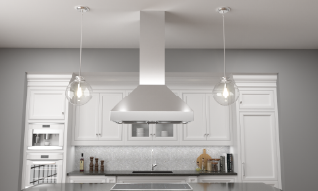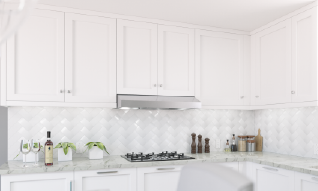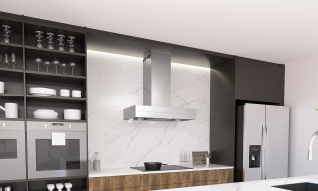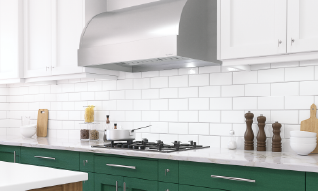PROUDLY PRODUCED IN THE U.S.A.
Menu
PROUDLY PRODUCED IN THE U.S.A.
Browse our list of Range Hood Troubleshooting topics for your Vent-A-Hood®. Click on your blower series below to find out more.
While Vent-A-Hood® range hoods are designed to provide years of trouble free operation, it still may be necessary to troubleshoot an issue when it occurs. Below is a list of common issues followed by the solution.
The purpose of a hood is to collect cooking contaminants and hold them until the blower unit can exhaust them to the outside. Therefore, it is necessary to size the hood based on the type of cooking equipment that is being used. Whenever possible, hoods should overlap the cooking equipment by at least 3 inches on each side. For an island application, this is considered mandatory. The hood should also project out to the front edge of the front burners. Finally, the height of the hood can affect its performance. Generally speaking, taller hoods are more suitable for professional style ranges, whereas under cabinet hoods are recommended for standard cooking equipment.
The duct should be smooth walled. Corrugated or “flex” type duct must not be used as it restricts airflow. The duct work should be the same square inch area (or larger) as the hood discharge for the entire length of the duct run. Run the duct as short and straight as possible. Enlarge the duct for longer duct runs. Maintain 4 to 5 foot spacing between turns. Turns should be smooth and gradual, not sharp and angled. Roof jack and wall louver openings must be free of obstacles, be at least as large as the duct size, and open freely (i.e. NOT spring-loaded).
The height of the hood off the cooking surface is very important. The higher the hood is mounted, the less effective it will be. Hoods only collect cooking vapors-they will not pull cooking contaminants back into the hood if they escape into the kitchen. Generally speaking, the deeper the hood, the higher the hood can hang and still be effective.
With the blower housing off, locate the damper (flap) and ensure that it opens and closes freely. If it does not, identify and remove any obstructions that are preventing the damper from opening. Screws protruding through the duct work are the most common obstruction. During installation, only duct tape should be used to attach transitions or duct work to the top of the hood. Screws that are used to connect duct work and transitions extend inside the duct work and may obstruct the damper from opening. During installation damper could be pushed into the blower housing. If this is the case simply push gently up on the damper until it clicks past and above the housing. A damper should rest on top of the blower housing when not in use.
This may be caused by the blower wheel coming in contact with the front edge of the blower housing or rubbing the motor mount screws. Un-snap the latches on the blower housing and make sure the housing is properly seated on the face of the motor housing. If the blower wheel is rubbing on the motor mount screws, the blower wheel will need to be repositioned on the motor shaft.
While Vent-A-Hood® range hoods are designed to provide years of trouble free operation, it still may be necessary to troubleshoot an issue when it occurs. Below is a list of common issues followed by the solution.
The purpose of a hood is to collect cooking contaminants and hold them until the blower unit can exhaust them to the outside. Therefore, it is necessary to size the hood based on the type of cooking equipment that is being used. Whenever possible, hoods should overlap the cooking equipment by at least 3 inches on each side. For an island application, this is considered mandatory. The hood should also project out to the front edge of the front burners. Finally, the height of the hood can affect its performance. Generally speaking, taller hoods are more suitable for professional style ranges, whereas under cabinet hoods are recommended for standard cooking equipment.
K250 Single Blower (250 CFM)- For standard electric and 4-burner gas or equivalent cooking equipment.
The duct should be smooth walled. Corrugated or “flex” type duct must not be used as it restricts airflow. The duct work should be the same square inch area (or larger) as the hood discharge for the entire length of the duct run. Run the duct as short and straight as possible. Enlarge the duct for longer duct runs. Maintain 4 to 5 foot spacing between turns. Turns should be smooth and gradual, not sharp and angled. Roof jack and wall louver openings must be free of obstacles, be at least as large as the duct size, and open freely (i.e. NOT spring-loaded).
The height of the hood off the cooking surface is very important. The higher the hood is mounted, the less effective it will be. Hoods only collect cooking vapors-they will not pull cooking contaminants back into the hood if they escape into the kitchen. Generally speaking, the deeper the hood, the higher the hood can hang and still be effective.
Under Cabinet 6” tall: 21-24”
With the grease pan removed, locate the damper (flap) and ensure that it opens and closes freely. If it does not, identify and remove any obstructions that are preventing the damper from opening. During installation, only duct tape should be used to attach transitions or duct work to the top of the hood.
This may be caused by the blower wheel coming in contact with the blower housing.
While Vent-A-Hood® range hoods are designed to provide years of trouble free operation, it still may be necessary to troubleshoot an issue when it occurs. Below is a list of common issues followed by the solution.
The purpose of a hood is to collect cooking contaminants and hold them until the blower unit can exhaust them to the outside. Therefore, it is necessary to size the hood based on the type of cooking equipment that is being used. Whenever possible, hoods should overlap the cooking equipment by at least 3 inches on each side. For an island application, this is considered mandatory. The hood should also project out to the front edge of the front burners. Finally, the height of the hood can affect its performance. Generally speaking, taller hoods are more suitable for professional style ranges, whereas under cabinet hoods are recommended for standard cooking equipment.
The duct should be smooth walled. Corrugated or “flex” type duct must not be used as it restricts airflow. The duct work should be the same square inch area (or larger) as the hood discharge for the entire length of the duct run. Run the duct as short and straight as possible. Enlarge the duct for longer duct runs. Maintain 4 to 5 foot spacing between turns. Turns should be smooth and gradual, not sharp and angled. Roof jack and wall louver openings must be free of obstacles, be at least as large as the duct size, and open freely (i.e. NOT spring-loaded).
The height of the hood off the cooking surface is very important. The higher the hood is mounted, the less effective it will be. Hoods only collect cooking vapors-they will not pull cooking contaminants back into the hood if they escape into the kitchen. Generally speaking, the deeper the hood, the higher the hood can hang and still be effective.
With the filter removed (see Hood Cleaning, Section B), locate the dampers (flaps) and ensure that they open and close freely. If they do not, identify and remove any obstructions that are preventing the dampers from opening. Screws protruding through the duct work are the most common obstruction.
During installation, only duct tape should be used to attach transitions or duct work to the top of the hood. Screws that are used to connect duct work and transitions extend inside the duct work and may obstruct the dampers from opening.
While Vent-A-Hood® range hoods are designed to provide years of trouble free operation, it still may be necessary to troubleshoot an issue when it occurs. The following is a list of the more common issues that may arise when using a Vent-A-Hood® range hood, followed by the specific solution to that particular issue.
The purpose of a hood is to collect cooking contaminants and hold them until the blower unit can exhaust them to the outside. Therefore, it is necessary to size the hood based on the type of cooking equipment that is being used. Whenever possible, hoods should overlap the cooking equipment by at least 3 inches on each side. For an island application, this is considered mandatory. The hood should also project out to the front edge of the front burners. Finally, the height of the hood can affect its performance. Generally speaking, taller hoods are more suitable for professional style ranges, whereas under cabinet hoods are recommended for standard cooking equipment.
M600 Single Blower (600 CFM)– Under cabinet for standard cooking equipment, gas or electric. Wall mount or island hoods for standard cooking equipment, gas or electric, and light usage professional style ranges.
M1200 Remote Blower (1200 CFM)– For larger and heavier use professional style ranges.
The duct should be smooth walled. Corrugated or “flex” type duct must not be used as it restricts airflow. The duct work should be the same square inch area (or larger) as the hood discharge for the entire length of the duct run. Run the duct as short and straight as possible. Enlarge the duct for longer duct runs. Maintain 4 to 5 foot spacing between turns. Turns should be smooth and gradual, not sharp and angled. Roof jack and wall louver openings must be free of obstacles, be at least as large as the duct size, and open freely.
The height of the hood off the cooking surface is very important. The higher the hood is mounted, the less effective it will be. Hoods only collect cooking vapors-they will not pull cooking contaminants back into the hood if they escape into the kitchen. Generally speaking, the deeper the hood, the higher the hood can hang and still be effective.
| Wall Mount | 30” |
| Standard Liner – MSLD | 24″-27” |
| Pro Liner – MPSLD | 27″-30” |
With the filter removed, locate the dampers (flaps) and ensure that they open and close freely. If they do not, identify and remove any obstructions that are preventing the dampers from opening. Screws protruding through the duct work are the most common obstruction.
During installation, only duct tape should be used to attach transitions or duct work to the top of the hood. Screws that are used to connect duct work and transitions extend inside the duct work and may obstruct the dampers from opening.
Note: If smoke still enters the kitchen after following these suggestions, contact you Distributor for additional service/suggestions.

To return to the Vent-A-Hood® Model you are currently designing (up to the point the SAVE PROGRESS button was clicked) copy and save the link below. To return, simply copy and paste the link into the web browser's address bar.







